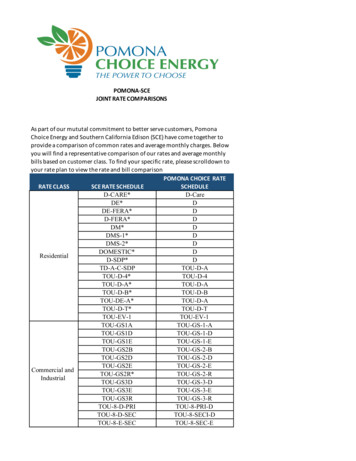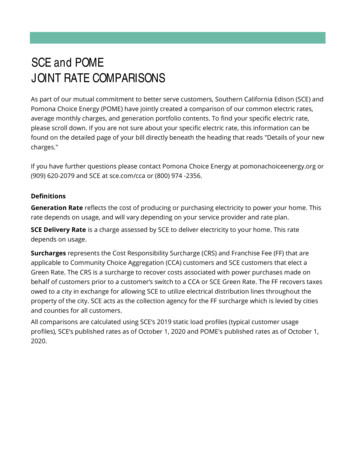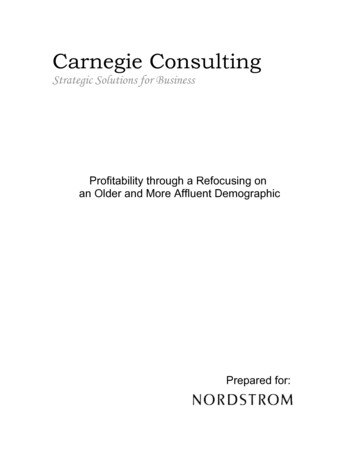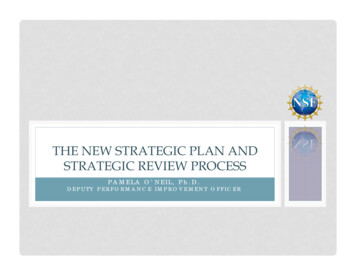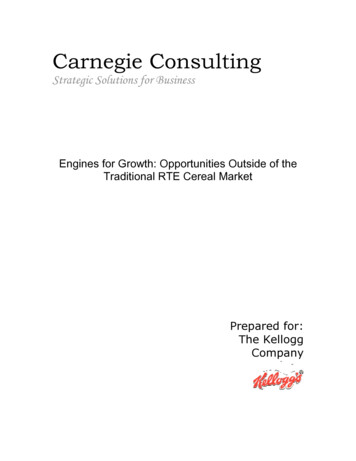
Transcription
Carnegie ConsultingStrategic Solutions for BusinessEngines for Growth: Opportunities Outside of theTraditional RTE Cereal MarketPrepared for:The KelloggCompany
Table of ContentsExecutive Summary. 2Company History . 2Internal Rivalry. 4Substitutes and Complements. 6Entry . 7Buyer Power . 9Supplier Power . 9Strengths, Weaknesses, Opportunities and Threats. 10Financial Outlook. 14Strategic Analysis: Engines for Growth . 17Conclusion . 18Carnegie Consulting425 N. College Ave s Claremont, CA 91711-1-
Executive SummaryOver the last century, the Kellogg Company has maintained a leading position in the readyto-eat (RTE) cereal market, enjoying healthy profit margins and steady growth. However,changing consumer tastes and increased competition within the industry have presented thecompany with new challenges. The RTE cereal industry has traditionally been dividedamong the “Big Three” cereal companies. They were able to quasi-cooperate to constraincompetition and increase profits. In recent years, this cooperation has eroded and privatelabel, household, cereals have gained market share, increasing the competition within theindustry. At the same time, the RTE cereal market has begun to decline because ofincreasing demand for mobile breakfast options. As consumers move to substitute goods,the RTE cereal market has contracted and competition for the remaining market hasintensified. Faced with a declining RTE cereal industry, Kellogg must look outside of its coremarket to find new growth opportunities.Carnegie Consulting recommends a framework for Kellogg to diversity into non-cerealmarkets. Kellogg must leverage its existing strengths in RTE cereal and other breakfastfoods into non-cereal product growth. As the first step, Kellogg must develop a culture thatrewards profitability over volume and evaluate future and current projects with the bottom-linein mind. This will lay the groundwork for steady earnings growth and establish the criteria forfuture product introductions. Next, Kellogg must build its brand name into a franchise thatrepresents high quality and healthy products. This will re-establish the original power of itsbrand name, which has been gradually diluted over the years. In addition, building apowerful, healthy umbrella brand will enable the company to maximize its efforts in the highmargin health food market and the rapidly growing snack market. Lastly, we advise Kelloggto incorporate into its Keebler snack products the same successful marketing strategies usedby Nabisco, the snack market industry leader. These recommendations taken together willenable the Kellogg Company to maintain steady earnings growth while reducing itsdependence on the weakening RTE cereal industry.Company HistoryThe Kellogg Company was founded by W.K. Kellogg in 1906, as The Battle Creek ToastedCorn Flake Company. W.K. Kellogg and Dr. John Kellogg ran the Seventh-Day Adventistsanitarium in Battle Creek, Michigan. In 1894, they invented flake cereal while searching fora way to make whole gains more appealing to their vegetarian clients. They accidentally lefta pot of boiled wheat to stand and the wheat became tempered. When the wheat was rolledeach grain emerged as a large thin flake. W.K Kellogg went on to produce corn flakes andestablish a market for ready-to-eat (RTE) cereal. Since its founding the Kellogg Companyhas been a leader in the industry, continuing to be the number one producer of RTE cerealsin the world after nearly a century.Battle Creek Toasted Corn Flake Company’s original factory burned down in 1907 and, toreplace it, the first building of the present-day Battle Creek Plant was built. Kellogg’s All-BranCereal was introduced in 1915. In 1922 the company was renamed the Kellogg Companyafter its founder, who died in 1951, at age 91. Rice Krispies were introduced in 1928. One ofKellogg’s most memorable, and lasting, advertising campaigns, Tony the Tiger and FrostedFlakes, was introduced in 1952. Kellogg branched into the toaster pastries market with theintroduction of Pop-Tarts in 1964. To capitalize on a natural food craze, Kellogg establishedCarnegie Consulting425 N. College Ave s Claremont, CA 91711-2-
its first line of whole-grain flaked cereal, Nutri-Grain, in 1981. In recent years Kellogg hasmade several large acquisitions to diversify its product offerings, buying Worthington FoodsCo. (producer of Morningstar Farms products) in 2000 and Keebler Foods Company (thesecond largest U.S. producer of cookies and crackers) in 2001. Throughout the company’shistory it has expanded all over the world, from its 1914 factory in London, Ontario to itsrecent plant in Guangzhou, China (opened in 1995).iChart 1 shows Kellogg’s increasing market value (since 1984). Over the years Kellogg’smarket value appreciated as its revenue base expanded, both in its core market of RTEcereal and in other business segments, such as snacks and cookies. The stock peaked inDecember of 1997, however, falling on concerns about the company’s future earningsgrowth. In recent years, the market value of the company has again begun to gain ground,as management has refocused on earnings growth and diversified some of its revenue baseout of the competitive RTE cereal market.Chart 1: Kellogg Market Value 12/17/1984 – 4/5/2002 ( Billions)20.018.016.0 9819840.0Source: finance.yahoo.comThe Kellogg Company’s brands include Kellogg’s , Keebler , Pop-Tarts , Eggo ,Cheez-It , Nutri-Grain , Rice Krispies , Special K , Murray , Austin , MorningstarFarms , Famous Amos , Carr’s , Plantation , and Kashi . Kellogg icons such asTony the Tiger , Snap! Crackle! Pop! , and Ernie Keebler are among the mostrecognized characters in advertising.iiCarnegie Consulting425 N. College Ave s Claremont, CA 91711-3-
Summary of Five-Forces Analysis of the RTE Cereal Industry in the U.S.ForceThreat to ProfitsInternal RivalryMedium to HighEntryLow to MediumSubstitutes and ComplementsHighSupplier PowerLowBuyer PowerMediumInternal RivalryKellogg is a leading producer in the cereal and convenience foods markets. The firm holdsstrong positions in numerous product lines within these industries. Kellogg possesses the #1snack/granola bars, toaster pastries, frozen waffles and veggie foods businesses. The #2RTE cereal, cookies and cracker positions are also held by Kellogg. Kellogg is currently the12th largest food and beverage company. The firm’s SIC code is 2043, cereal breakfastfoods.iiiThe U.S. Department of Agriculture estimates total food and beverage sales for 2000 to havebeen 802.3 billion, an 8.4% increase from 1999.iv This figure includes 442.4 billion inproducts for consumption at home and 359.9 billion for products away from home. Majorchanges in the cereal and snack foods markets are driven mainly by changing demographics,i.e. the aging baby boomers and their slowing metabolisms, and a change of life style anddietary habits necessitating quick, easy meals.vKellogg relies on a widely diverse geographic base for its revenues. Nearly 70% of revenuesare generated throughout the United States. Europe and Latin America provide 15% and 7%of revenues, respectively, and the balance is drawn from Asia, Australia and Canada.Kellogg significantly leads its cereal competitors in the international markets.Some of Kellogg’s top competitors include General Mills, Post (subsidiary of Kraft foods),Quaker Oats (subsidiary of PepsiCo), Danone and Interstate Bakeries. Many of these firmscompete with Kellogg in only one or two product segments, such as Quaker Oats in thecereal and snack business and Danone in the cookies, crackers and snacks businesses.The RTE cereal industry has historically been divided among three main competitors, alltracing their history to the turn of the 20th century. They are commonly referred to as the BigThree and are comprised of Kellogg, General Mills, and Post. Quaker has been a smallercompetitor as well. Throughout the 20th century, the RTE cereal industry has grown steadilyin size, both in volume and in sales. The compound average annual volume growth rate from1950 to 1993 was 3%, representing reasonable, but not fast, growth over the years.vi Thishelped to minimize internal competition among the Big Three. Various trends in cerealconsumption have fueled this growth of the past century: During the Second World Warcereal producers introduced vitamin-fortified cereals; pre-sweetening gained extensiveCarnegie Consulting425 N. College Ave s Claremont, CA 91711-4-
popularity throughout the 1950s; and in the 1970s and 1980s granola and natural cerealsgrew in demand.viiThe branded RTE cereal industry has been very profitable for the largest manufacturers, withreturn on assets in the industry routinely in the 15%-30% range.viii Over the years thisprofitability did not attract significant entry into the market and the industry continued toconcentrate. In 1972, Kellogg and its two major competitors at the time (General Mills andGeneral Foods) were accused by the Federal Trade Commission of anticompetitive behavior.Industry experts argued that the Big Three restrained competition among themselves throughunwritten agreements to limit methods of competition that would inflate short-term profits atthe cost of long term industry profitability. The practices cited were: in-pack premiums (e.g.free toys) were restricted by each company to one brand at a time; trade dealing (i.e.discounts to retailers for special treatment) was banned; and widespread vitamin fortificationwas limited.ix The antitrust suit dragged on for several years and was eventually droppedwith the election of President Reagan in 1981. In the meantime, many early entrants into thenatural cereal market that had emerged in the 1970s had been crushed by the natural cerealbrands owned by the Big Three. The Big Three now face their biggest threat in the privatelabel brands and the increasingly intense internal competition among themselves.The market has become increasingly competitive over the past decade, with private labelsales cutting into the Big Three’s market share. Additionally, increasing pressure to engineergrowth in a stagnant market has led to more competitive pricing and increasing costs. Thetraditional unwritten agreements between the Big Three have come under increasingpressure as the temptation to achieve short-term sales growth at the cost of long-termindustry margins increases. RTE cereal manufacturers can no longer rely on market-widegrowth and have turned to capturing market share to fuel the growth expectations of theequity market.Carnegie Consulting425 N. College Ave s Claremont, CA 91711-5-
Substitutes and ComplementsSubstitutesSubstitutes pose substantial threats to profitability and growth in the RTE cereal market. Inrecent years RTE cereal industry has experienced a considerable weakening in demand, asconsumers’ preferences, especially in the breakfast market, have shifted towards greaterconvenience and speed. Over the past decade consumers have moved towards a moremobile lifestyle, which does not include the traditional sit down breakfast. Common mobilealternatives to cereal for breakfast include toaster pastries (e.g. Pop-Tarts), health bars (e.g.granola bars, Breakfast Bars, etc), health drinks (e.g. smoothies, breakfast drinks, premiumjuices, etc), pastries (e.g. donuts, scones, etc), and bagels. Even when consumers sit-downfor breakfast, they may choose waffles, pancakes, hot cereal, or one of the common mobilealternatives mentioned above.The substitutes, in both the mobile and sit-down categories, are generally pricedcompetitively relative to cereal and are available from many of the retailers that sell cereal,resulting in minimal search costs for price comparisons. RTE cereal faces competition fromthese alternative breakfasts at two main decision points, purchasing and consumption.Customers often decide to purchase cereal, but do not consume it regularly because of thevarious other breakfast options. In order to generate sales, cereal manufactures mustconvince consumers both to purchase their goods and to consume them.The substitutes for the cereal industry currently provide significant pressure on the industriesprofit potential. If the trend towards a busy and mobile lifestyle continues, the profit picturefor the RTE cereal industry will continue to deteriorate.ComplementsThe RTE cereal industry benefits from lower prices in the milk market. The milk industry iscereal’s biggest complement, with the two products intertwined in people’s minds. Fewconsumers eat cereal without milk, making milk an essential part of most consumers’ cerealbreakfasts. When purchasing cereal, customers often factor in the cost of milk.Juice, especially Orange and Apple, and various breakfast fruits are also complements tocereal. Like milk, they are often a part of a complete cereal breakfast. Additionally, theyprovide extra incentive for consumers to eat a sit-down meal instead of a more mobilebreakfast, which rarely includes cereal (as discussed above in the substitutes section).Carnegie Consulting425 N. College Ave s Claremont, CA 91711-6-
EntryKellogg, General Mills, and Post (a division of Phillip Morris) dominate the 7.6 billion marketfor RTE cereal.x In 1999, these three companies accounted for approximately 84% of allRTE cereal sales.xi Due perhaps to the high level of market concentration, profit marginshave remained high. However, even with high margins, entry into the branded cereal markethas been substantially curtailed. Private label brands of retail chains have made someinroads.Brand loyalty has provided a significant barrier to entry for potential entrants. Customers inthe RTE cereal market historically have been shown to have inelastic demand for establishedcereal brands. Children are a major consumer of RTE cereal and after watchingadvertisements for Rice Crispies or Lucky Charms, children are not willing to settle forgeneric or off-brand cereals. In addition, adults are willing to pay premiums for establishedbrands due to brand loyalty developed throughout their own childhood.Initial expenditures required to effectively promote and introduce a new product into themarket are quite large. Recent product introductions from Kellogg and General Millsreportedly cost, on average in the first year, 20 million in advertising alone.xii In addition,large manufacturers are able to realize economies of scale in advertising. Largermanufacturers are able to purchase ad space, whether on TV or in magazines, in largervolumes and, therefore, for discounted prices. The advertising for particular brands providesan external spillover over onto other similar, company products, providing some economiesof scope in advertising. In the 1990’s, companies began to introduce “co-branded” cereals,cereals manufactured by one of the market leaders but relying on the brand name of anotherproduct. Examples range from Sulley, the main character in Disney/Pixar’s Monster.inc,appearing on the box for Kellogg’s Apple Jacks to a Kellogg’s The Power Puff Girls, a hitcartoon on the Cartoon Network, cereal. The market leaders have additional economies ofscope in advertising due to the decreased costs associated with developing a product’sindividual brand by co-branding it with other existing products.Beyond the advantages that existing cereal manufacturers have with regard to their existingbrands and the economies of scale and scope in advertising, the largest barrier to entry tothe market is the huge initial start-up fees associated with building a new plant andestablishing product distribution channels. These initial costs are large and dissuade mostwould-be entrants from entering the market, regardless of the potential economic rents thatcould be gained from taking advantage of the existing cereals being priced above theirmarginal cost. The existence of large economies of scale in basically all facets of the cerealindustry and the large set-up costs mean that the branded cereal market does not face manypotential market entrants. Economies of scale exist for manufacturing, marketing,purchasing, and research and development.An additional barrier to entry is the common practice among supermarkets and other RTEcereal distribution points to require higher margins from new cereal entrants to stock theirbrands in the coveted center isle positions. New cereal companies that do not pay the storesa premium receive less-valuable shelf space because space is allocated in proportion toCarnegie Consulting425 N. College Ave s Claremont, CA 91711-7-
historical sales. In recent years there has been a strong move by private label manufacturersinto the cereal business. Private label manufacturers are often owned by the supermarketsand supermarkets often receive a higher rate of return for them. This creates some incentivefor supermarkets to place private label cereal in better self locations to boost sales. Privatelabel manufacturers do not generally engage in promotion or perform extensive research anddevelopment. Lower costs facilitate their entry into the RTE cereal business. This advantageso far has not been sufficient to take substantial market share from Kellogg, General Mills,Post and Quaker because these national brands benefit from decades of expenditures onadvertising and promotion, building strong brand loyalty.The market share of private labels into the RTE cereal market has increased somewhat inrecent years. By 1999, private-label cereals accounted for over 10% of total RTE cerealsales volume, an increase from less than 3% in 1980xiii. This growth in sales of private-labelcereals appears to be continuing as chain supermarkets and other increased numbers ofretailers introduce their own brands of cereal and other products and distribute them in theirstores for a lower price than the branded equivalents. Although, as of yet, the Big Threehave been able to maintain their profit margins, continued entry by private labelmanufacturers would erode their sales and profit margins.Carnegie Consulting425 N. College Ave s Claremont, CA 91711-8-
Buyer PowerThe bargaining power of buyers, both retailers and consumers, has become an increasingthreat to the RTE cereal market over the past several decades. Prior to the 1970’s, theprimary purchasers of cereal were small, independent retailers who stocked only what theircustomers demanded on a short-term basis to fill their stores. Due to the relatively smallamount of cereal that each of these small stores demanded, these independent stores wereunable to enact any sort of bargaining power on the major cereal manufacturers. Commonlythese small retailers didn’t even deal with manufacturers. They bought their inventories ofcereal from local and regional wholesalers. However, as time passed, the size of retailersgrew and so did their bargaining power.Discount retailers have been consistently gaining market share in recent years. The marketstrategy of discounters has been to stock goods at competitive prices that are demanded by“value” consumers.xiv In order to do this, discount retailers such as Wal-Mart and Food-4Less buy their cereal in large purchases, store the food in their own large warehouses, andthen stock it themselves when necessary demand occurs in their outlets. Given the size ofthese large purchases, these stores often demand and receive volume discounts.As a result of merger activity, chain grocery stores have achieved increased concentrationratios, not only in metropolitan market areas but nationally as well. This consolidation givesthem the ability to successfully demand discounted prices for volume purchases fromcompanies like Kellogg. In addition, several chain grocery stores currently produce their ownbranded cereals such as “Safeway Select Cheerios,” and can leverage this position intoadvantageous pricing positions from the Big Three cereal producers.Kellogg’s largest customers, like Wal-Mart, have the power to demand that their suppliersperform work once done by the retailers themselves. For example, in addition to preparing instore promotional materials, a long-standing practice, Kellogg and other companies are todayasked to pre-sort merchandise on pads that can easily be dropped into place in the store.Even more important, companies like Wal-Mart are now shifting the risk of forecasting theirsales and inventory requirements on to their suppliers. Kellogg must provide just-in-timeproduct to such chains. Companies like Kellogg today find that the ability to forecast sales,shipments and inventories to service their largest buyers is now one of the key requirementsfor success.Supplier PowerThe bargaining power of Kellogg’s suppliers, by contrast, is rather insignificant. The bulk ofraw materials Kellogg requires to produce cereal are commodity items such as grains andwheat are available to Kellogg through a large number of both large and small distributors.Packaging companies have little power over Kellogg since there are numerous companiesthat Kellogg may solicit to fill their packaging needs at a minimal transfer cost if Kellogg’ssuppliers decide to increase prices.Carnegie Consulting425 N. College Ave s Claremont, CA 91711-9-
Strengths, Weaknesses, Opportunities and ThreatsStrengthsBrand RecognitionThe Kellogg’s brand is one of the most powerful brand names in the world. The brandprovides a significant competitive advantage for Kellogg in both its core cereal market and innew product categories, such as snack foods. In a BusinessWeek study, released during thesummer of 2001, in a comparison of the value of the top 100 brands in the world, Kelloggranked 39th. This is significantly ahead of Kraft, a major competitor in snack food, whichranked 65th. None of the other cereal brands even made the list. Business Week’s analysiswas done by InterBrand, a pioneering brand consultancy in New York. InterBrand’smethodology was to estimate the present value of the cash flows stemming from the brand toextrapolate its market value. The Kellogg’s brand was estimated to be worth 7.01 billion in2001 although this was a 5% decrease from its 2000 value of 7.36 billion.xvKellogg has developed a branding and management strategy that targets growing high profitmarkets. Because of the firm’s success in branding, Kellogg products are able to commandhigher prices and the firm typically operates at a slightly higher than average profit marginthan its rivals in the RTE industry. The prospect of leveraging this brand name in new marketsegments should prove to be an important strength for the company’s near term profitability.In-depth Knowledge of Breakfast IndustryAs the oldest of the Big Three cereal manufacturers, Kellogg has significant knowledge aboutthe RTE cereal industry, both on the consumer and the manufacturing sides. This knowledgebase offers the Big Three, and especially Kellogg, a competitive advantage against newerentrants into the market. Kellogg’s experiences in the RTE cereal industry and its early entryinto many alternative breakfast markets, such as the introduction of Pop-Tarts toasterpastries in 1964, has created an extensive institutional knowledge about the breakfast marketas a whole. This gives the company an additionally advantage when it expands into otherbreakfast-type food markets, such as breakfast bars and many natural foods. These newmarkets are often served by niche players, who lack the breakfast-wide viewpoint of Kellogg.Economies of ScaleThe Kellogg Company, with an approximate RTE cereal market share (by dollars) of 31% inNorth American and nearly 40% globally, has large scale advantages. Its size reduces theunit cost of production and distribution, especially in bagging production.xvi While the otherBig Three firms have similar advantages of scale, smaller competitors, especially nichemarket manufacturers (e.g. health food companies), have difficulty overcoming their scaleand scope disadvantages. Scale allows Kellogg to spread its hefty fixed costs, such asadvertising and research and development (R&D), over a large volume of sales per item, andacross a large number of products and product lines. This is especially true in advertising,where many of Kellogg’s products are double-branded. The double-branded products (e.g.Kellogg’s Rice Crispies) receive positive reputation spill over effects from other products’advertised under the Kellogg’s common brand. The Kellogg/Keebler combination also givesCarnegie Consulting425 N. College Ave s Claremont, CA 91711- 10 -
the company power to negotiate co-branding licensing agreements, which, for 2002, includeagreements with NASCAR, the Cartoon Network, and Disney.Diversified Product Offerings with Economies of ScopeKellogg’s strong ability to scale into other markets is partially covered in the knowledgesection, but additional company advantages augment these economies of scope. Many ofthe production facilities, advertising campaigns, and distribution methods are interchangeablebetween RTE cereal and other snack and breakfast-type markets. Kellogg has been able togenerate significant synergies by developing a strong presence in the snack, cookie, andnatural food markets. They have developed their presence through several large acquisitionsand are now the number two player in the cookie and cracker market.WeaknessesHistorical Focus on VolumeKellogg historically has focused on volume measures to determine its performance in theRTE cereal market, downplaying product profitability. This has been an industry-widestandard and Kellogg has recently begun to re-evaluate it. Volume performance evaluationsdistort the company’s sales force efforts. For instance, in the past, Kellogg’s sales teamsconcentrated on selling large heavy cereal boxes in order to boost the company’s volumefigures. To illustrate the divergence of profit and volume measurements one can look at thesale of a 25.5 oz. box of Kellogg’s Raisin Bran compared to that of a 12 oz. box of Kellogg’sSpecial K: red berries. Using indexed prices, the average unit price of the Raisin Bran boxwould be 100 while the smaller Special K box would fetch 114. This yields a profit margin of125 for the Special K, compared to a mere 100 for the larger Raisin Bran box.xvii Over thelast year, management has shifted to prioritizing cash flow and net sales over volume, but thecompany’s product portfolio continues to be burdened by low-return cereals.xviii Addressingthe historical volume emphasis must be a key element of Kellogg’s strategic plan goingforward.Limited Financial FlexibilityKellogg’s acquisition of debt-ridden Keebler caused a dramatic increase in the company’sbalance sheet liabilities, resulting in credit downgrades and reduced financial flexibility. Thishas limited the firm’s ability to focus on growth opportunities because it must use availablecash flows for interest expenses and paying down its debt. This weakness is analyzed inmore detail in the financial overview section of this report.OpportunitiesHigh Growth SectorsWhile Kellogg’s traditional RTE cereal business has experienced slowing growth because ofthe industry-wide trends discussed earlier, several of its smaller segments presentsubstantial growth opportunities. This is particularly true for the health food and snack foodsegments. In 2001, Kellogg’s Kashi brand of healthy natural foods achieved unusually largeretail sales growth (68%). Additionally, last year its Morningstar Farms brand, whichCarnegie Consulting425 N. College Ave s Claremont, CA 91711- 11 -
specializes in veggie foods, experienced 5% retail sales growth.xix These are two ofKellogg’s most promising brands and categories for fueling future growthDirect Store Door (DSD) Delivery SystemKeebler’s direct store door (DSD) delivery system provides Kellogg with a powerfuldistribution system to achieve market penetration for many of its snack, cracker, and cookieproducts. In a DSD system the product is brought into the store by Kellogg employees,rather than being dropped off at retailer’s warehouses. The Kellogg’s employees rotate theproducts,, monitor and refresh inventories, and set up displays. The Keebler DSD systemstrengthens Kellogg’s presence in both traditional supermarkets and non-traditional channels,such as convenience and gas stores, vending machines, foodservice, club stores, and massmerchandise stores. Kellogg has already begun to distribute Nutri-Grain Bars and RiceKrispies Treats through the system and during the 24-week period (8/12/01 to 1/27/02) retailsales increased (year-over-year) by 5% and 37%, respectively. Additionally, the DSDdelivery system enhances Kellogg’s control over how their products are displayed. Thisresulted in a year-over-year increase in display activity of 134%, during the period, for NutriGrain Bars and a 126% increase for Rice Krispies Treats.xx These gains are only thebeginning of DSD’s potential for fueling Kellogg’s growth in the expanding snack market.DSD systems are more expensive than traditional retail channels, but for Kellogg/Kee
margin health food market and the rapidly growing snack market. Lastly, we advise Kellogg to incorporate into its Keebler snack products the same successful marketing strategies used by Nabisco, the snack market industry leader. These recommendations taken together will enable the Kellogg
